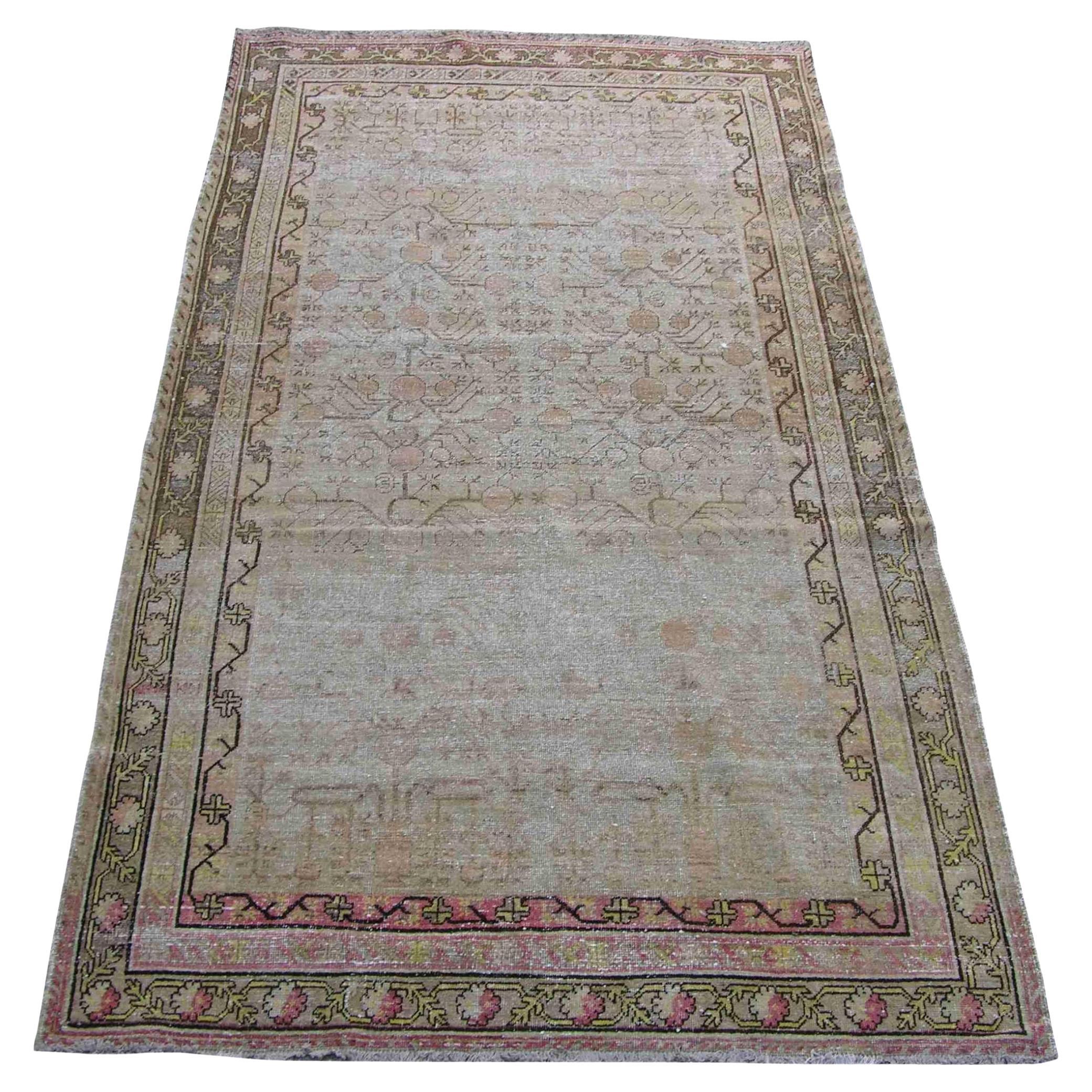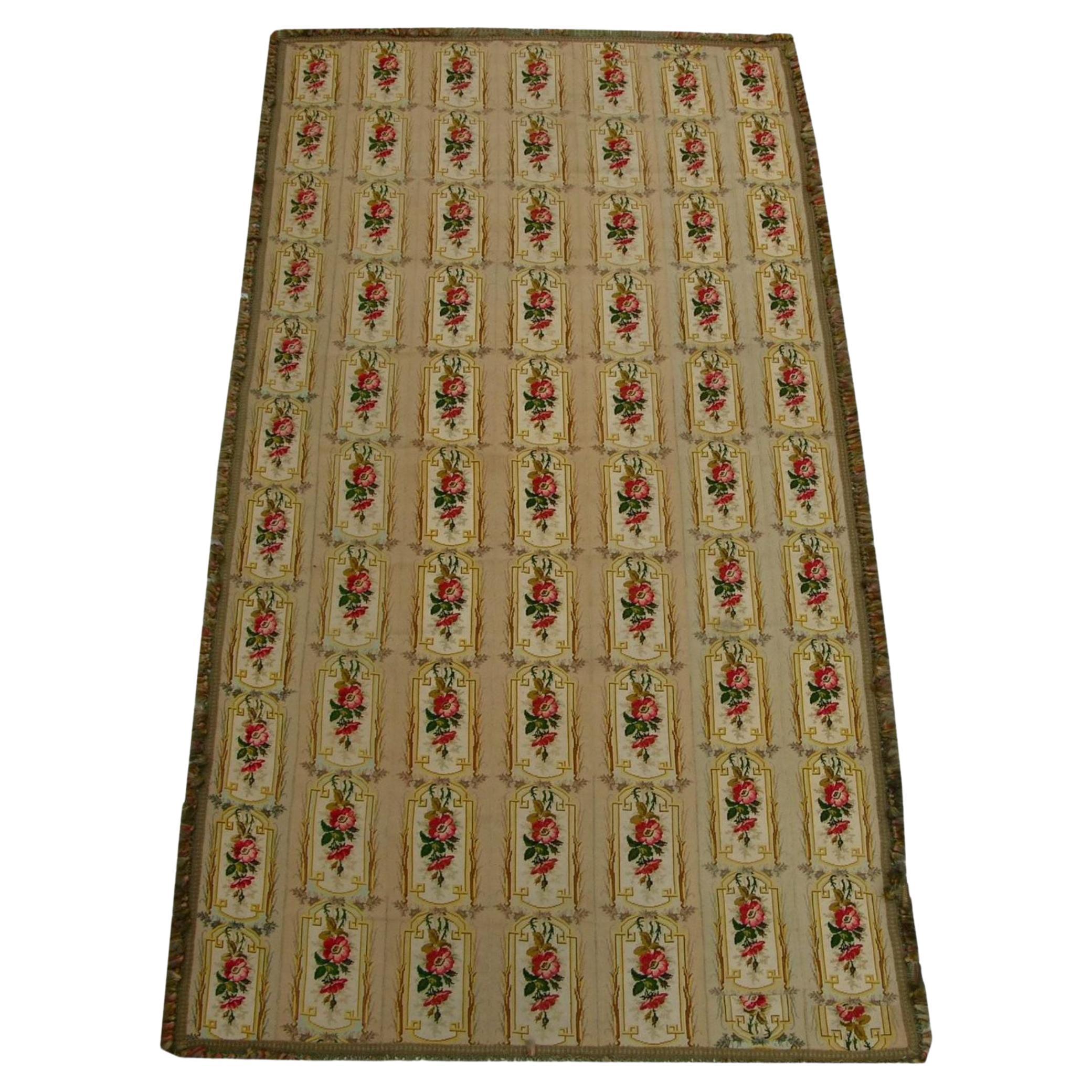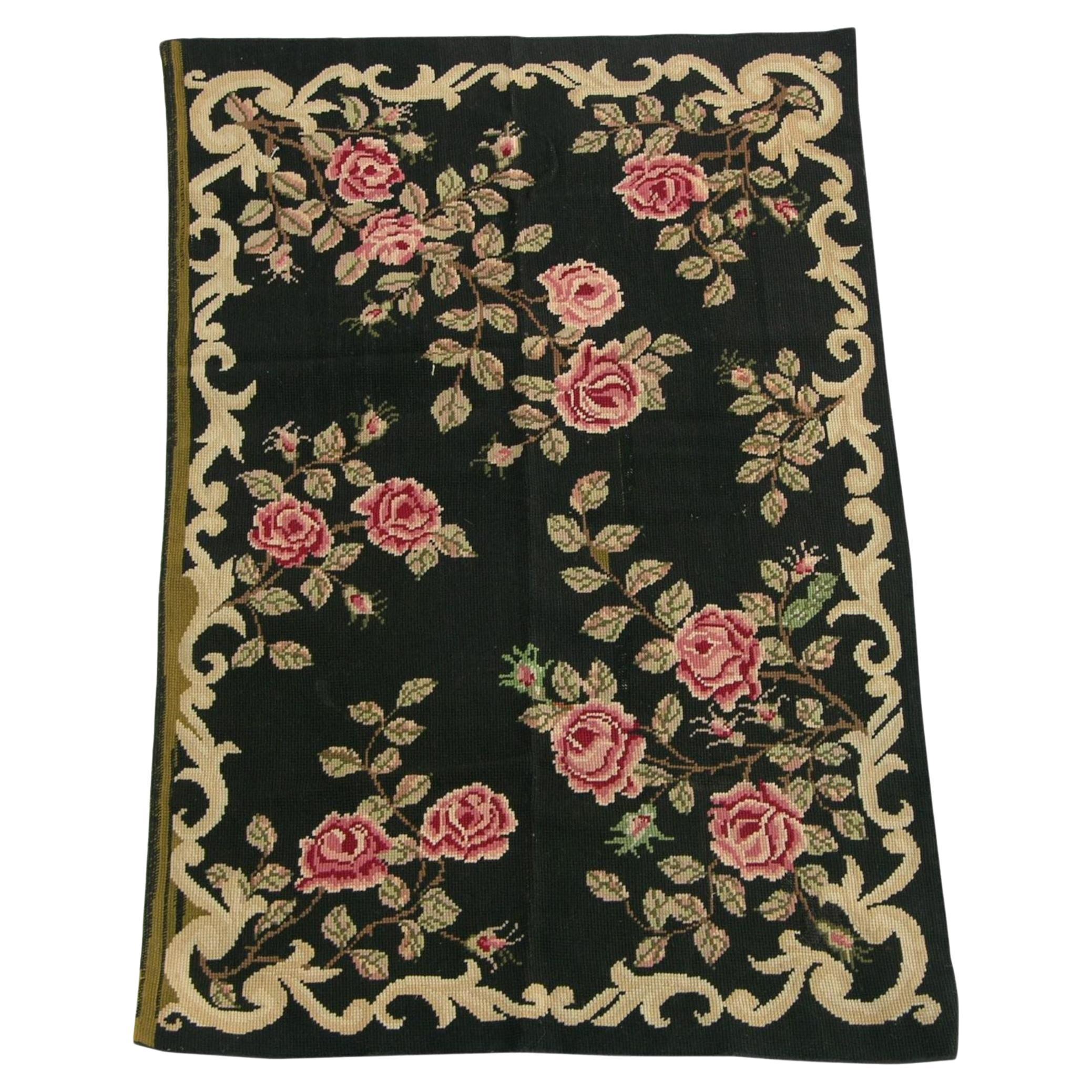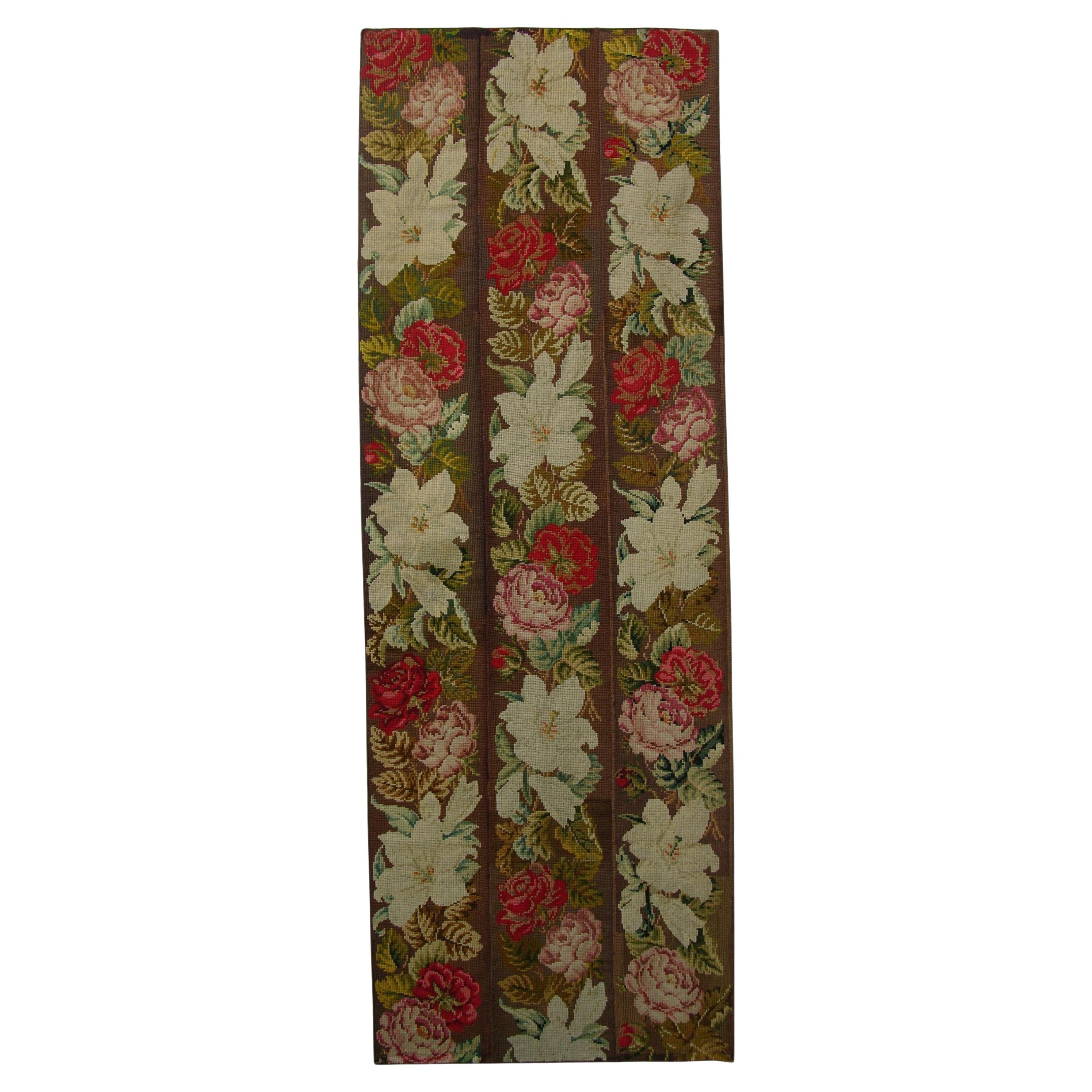Items Similar to 1920s Antique Floral Design Part Silk Needlework Rug
Want more images or videos?
Request additional images or videos from the seller
1 of 5
1920s Antique Floral Design Part Silk Needlework Rug
About the Item
Needlepoint rugs were created using the traditional needlework weaving technique that is used to make everyday items from furniture to carpets and artwork. However, it has a fascinating history both as a hobby and as an industry. When many people think of carpets, they think of pile carpets or flat weave kilims, but needlepoint has also been used to create beautiful carpets. These carpets are durable and an important part of carpet history.
Archaeologists and scholars consider the roots of needlepoint to have been around 1500 BC. They consider the first needlepoint to include the fine diagonal stitches that were used to sew tents together by the ancient Egyptians. The art eventually evolved into tapestry weaving. However, a tapestry weaving differs significantly from needlepoint in that it uses a loom and vertical warp.
Tapestry weaving is closer to the weaving of kilims and pile rugs than canvas work. However, some still include tapestry weaving in the category of needlepoint because of the fine work that appeared during the late Renaissance. It can have a similar appearance to the untrained eye. Technically, tapestry weaving and needlepoint are not the same, and they do not use the same technique.
The first actual needlepoint rugs and needle-points began to appear in the late Renaissance. Needlepoint is worked by creating stitches on a stiff canvas. The canvas is typically made from jute or linen and is quite durable. Pieces from the Renaissance were used to cover footstools, chairs, pillows, bed headboards, and other furnishings. They were also used as table coverings and wall coverings. You could also find them on many small items such as purses, shoes, and various adornments for clothing.
During the Renaissance, the craft reached a high level of skill, and the designs became incredibly detailed and realistic. They mimicked many of the subjects and styles of famous paintings of the time. They created florals, still life designs, scenes, and geometric tiled pieces. Some of them mimicked the designs found in Persian Carpets.
Needlepoint reached its peak popularity in the 19th century when it was considered a proper occupation for a lady. Needlepoint and embroidery held a similar place in societal status at the time. During this time, the work became finer, with some of the canvas reaching a high level of detail. The level of detail is determined by counting the number of mesh in an inch. During this time petit point by French needlewomen could have a mesh count as high as 45 mesh. This allowed women to create highly intricate designs with incredible levels of detail.
It is possible to find many antique pieces of needlepoint besides rugs. Needlepoint rugs were popular in France and Spain, where the technique was adapted to create highly intricate designs that mimicked the designs in architecture and fashion. They were popular because they were durable, and it could be fashioned into a variety of items. The canvases themselves were durable, and the wool that they used was also strong, which means that many of the pieces were able to withstand daily use. We have many artifacts that have survived from this time period.
Needlepoint rugs are important collectibles because they are different from the pile rugs and kilims that are typically found on the market. Needlepoint carpets are special because they take many hours to create, especially larger works. Needlepoint pieces of any type became popular throughout Europe during the 19th century. It is still a popular hobby today, but perhaps one of the most interesting stories is that of the Portuguese needlewomen of Arraiolos.
The story of these women and their beautiful carpets begins in 1492. Needlepoint was a popular occupation in Spain, which had a large population of Moors and Jews. They were an integral part of Spanish culture. However, in 1492, Queen Isabella of Spain issued a proclamation that gave these ethnic groups the order to pack their bags and board ships headed for shores unknown.
They had little time to grab their personal items and were only allowed to take items that were necessary for them to make a living and survive. All else had to be left behind. On one of these ships, a group of Jewish immigrants arrived in the southern Portuguese village of Arraiolos. They had very little with them to begin their new life, but the women had skills of needlework and began creating beautiful carpets that they could sell to support their families.
It became an important part of the community culture, and in the village groups of women could often be seen sitting together and working on these rugs. The designs are similar to those found on Spanish tilework. They brought these designs with them in their memory, and many of the rugs created by them resemble the colorful azulejo tiles. The beautiful design colors created by these women found their way into the European marketplace and became treasured heirloom pieces.
The Jewish women with their knowledge were able to take their displacement and tragedy to create beautiful works of art that would become famous around the world. Needlepoint rugs are a special place among carpet collectors and one that everyone should explore for the magnificent pieces that are available.
The technique for creating needlepoint rugs and other objects made from needlepoint has remained unchanged since its beginnings in the 17th century. It all begins with a canvas with evenly spaced warp and weft. It is often stiffened and made from an extremely durable material such as jute, cotton, or other suitable materials. Historically, canvases were made from jute or linen.
It also requires thick, durable wool yarn in many bright colors. Many of the historical rugs were created using only natural vegetable dyes that were available in the area. However, do not think of this as a limited color palette because the range of colors found in needlepoint rugs includes almost every color in the rainbow. Both the spinners and the wool dyers were highly skilled in their craft. This provided the artist who created the needlepoint carpets with a vast array of colors to use in their works.
The process of creating a needlepoint rug involves making stitches diagonally across the intersections of the canvas. It is interesting to note that until the 19th century, the term needlepoint was not used. This work was referred to as canvas work previously. The patterns are created by changing colors in the stitches.
In the early pieces, there is only one stitch used to create the pieces. However, through the years, over 150 stitch variations developed. The stitch variations are created by the intersection of stitches into a single space or a combination of long and small stitches. These stitch variations became more popular in more recent work, such as those produced since the 1970s.
However, you will find different stitches in the Italian Bargello work of the 19th century, but for the most part, historical pieces used only the most basic stitch. The artistic design that was similar to painting on canvas with the colors, only the stitches are the brush strokes. Once the piece is finished, the edges are bound using a binding stitch, and it can be sewn onto a backing cloth if desired.
Making a needlepoint carpet is a relatively simple process and uses few materials. It is a long process and requires many hours of dedication and work. You are encouraged to explore the many different needlepoint rugs that occasionally make their way into our collection. Now that you understand the process and a little bit more about them, you can truly appreciate the works of art that they are and why there are an essential that everyone should have in their collection
- Dimensions:Width: 69 in (175.26 cm)Length: 117 in (297.18 cm)
- Style:Renaissance Revival (In the Style Of)
- Materials and Techniques:
- Period:
- Date of Manufacture:1920
- Condition:Good Condition.
- Seller Location:Los Angeles, US
- Reference Number:
About the Seller
5.0
Gold Seller
These expertly vetted sellers are highly rated and consistently exceed customer expectations.
Established in 1920
1stDibs seller since 2023
26 sales on 1stDibs
Typical response time: <1 hour
- ShippingRetrieving quote...Ships From: Los Angeles, US
- Return PolicyA return for this item may be initiated within 3 days of delivery.
More From This SellerView All
- 1920 Antique Floral Needlework RugLocated in Los Angeles, USNeedlepoint rugs were created using the traditional needlework weaving technique that is used to make everyday items from furniture to carpets and artwork. However, it has a fascinat...Category
Vintage 1920s Other Russian and Scandinavian Rugs
MaterialsWool, Cotton
- Antique Needlework Floral DesignLocated in Los Angeles, USNeedlepoint rugs were created using the traditional needlework weaving technique that is used to make everyday items from furniture to carpets and artwork. However, it has a fascinat...Category
Antique Early 1900s Other Russian and Scandinavian Rugs
MaterialsWool, Cotton
- Antique Needlework Floral DesignLocated in Los Angeles, USNeedlepoint rugs were created using the traditional needlework weaving technique that is used to make everyday items from furniture to carpets and artwork. However, it has a fascinat...Category
Antique Early 1900s Other Russian and Scandinavian Rugs
MaterialsWool, Cotton
- 1920s Antique Floral Samarkand RugLocated in Los Angeles, USAntique Samarkand Rugs: The desert oasis of Khotan was an important stop on the Silk Road. The people of Khotan were expert carpet weavers who produced high quality antique rugs and ...Category
Vintage 1920s Other Russian and Scandinavian Rugs
MaterialsWool, Cotton
- Antique Needlework Floral RugLocated in Los Angeles, USNeedlepoint rugs were created using the traditional needlework weaving technique that is used to make everyday items from furniture to carpets and artwork. However, it has a fascinat...Category
Antique Early 1900s Asian Other Russian and Scandinavian Rugs
MaterialsWool, Cotton
- 1900s Antique Needlework Floral DesignLocated in Los Angeles, USNeedlepoint rugs were created using the traditional needlework weaving technique that is used to make everyday items from furniture to carpets and artwork. However, it has a fascinat...Category
Antique Early 1900s Other Russian and Scandinavian Rugs
MaterialsWool, Cotton
You May Also Like
- Antique Russian Tekke Turkman Rug from 1920sLocated in New York, NYAntique Russian Tekke Turkman rug from 1920s ( 3' 6" x 6' - 106 x 182 cm).Category
Antique Early 1900s Russian Russian and Scandinavian Rugs
MaterialsWool
- Bessarabian Kilim Rug, c.1920sLocated in Savannah, GAA Bessarabian Kilim rug, circa 1920s. 76 by 117 inchesCategory
Vintage 1920s Moldovan Other Russian and Scandinavian Rugs
MaterialsWool
- Floral Medallion Antique Sarouk Persian Rug Circa 1920Located in New York, NYFloral Medallion Antique Sarouk Persian Rug Circa 1920Category
Early 20th Century Russian and Scandinavian Rugs
MaterialsWool
- Hamadan Vintage Olive Green Rug Circa 1920sLocated in New York, NYOverwashed, modern aesthetic, faded olive Hamadan rug (Persian) with beautiful allover fieldCategory
Early 20th Century Russian and Scandinavian Rugs
MaterialsWool
- Striking Bessarabian Kilim, c. 1920sLocated in London, GBThe tradition of Bessarabian kilim weaving dates to the later period of Ottoman rule over the Eastern Balkans – broadly, the territory now covered by Bulgaria and Moldova – and is kn...Category
Vintage 1920s Balkan Bessarabian Russian and Scandinavian Rugs
MaterialsWool
- Swedish Kilim Cross Motif Design Rug, 1920-1950Located in Ferrara, ITThis is a semi-antique Swedish kilim woven circa 1920-1950 and it measures 235 X 172 CM. It features a simplistic pattern with geometric cross motifs that...Category
Early 20th Century Swedish Scandinavian Modern Russian and Scandinavian ...
MaterialsWool





